Buffalo Soldiers: Living for Death in the Tana Toraja
“Are funerals like this in London?” asks my new Torajan friend.
The dead man’s drum-shaped coffin emerges from the matrimonial bedroom where he has “slept”, preserved in formalin, with his family for the last eight months. Now he has left the house, he is finally dead, his soul winging its way towards the afterlife.
“Not really,” I say. “People are always buried within about a week of their death. Normally we put them in the ground. Sometimes we burn the bodies.”
As if sensing that one of their souls will shortly follow the dear departed, the pigs, hogtied with strips of bamboo bark in the noonday, equatorial sun, reach a crescendo of screaming.
“What do you sacrifice?” he asks.
“We don’t have sacrifices in England,” I say.
“Not even a chicken?” he asks, clearly shocked and politely disapproving that our dead could pass into the afterlife unescorted by even the lowest of creatures.
“Not even a chicken,” I say, apologetically, thinking of the sandwiches, cocktail sausages, olives, quiche and French fizz at my grandmother’s funeral eighteen months ago and a world away.
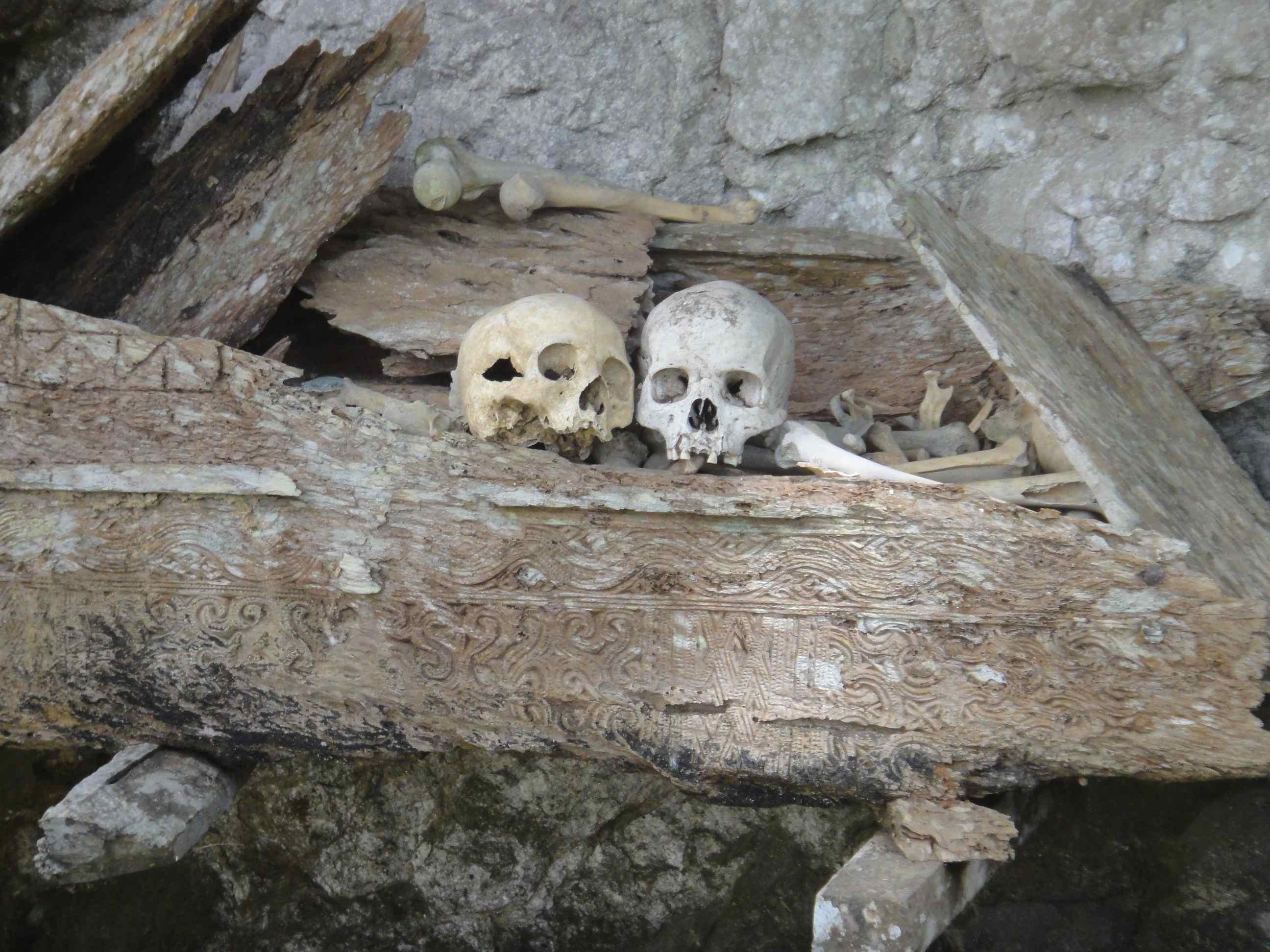
Like my grandmother, though, like the deceased, like the other funeral guests, and like the folk whose bodies lie below the hanging graves in the nearby village, my interlocutor is a practising Christian.


Here in the dazzling highlands of south central Sulawesi, where jagged mountains fling out green hills like flying buttresses, rice terraces tumble like mirrored staircases and surrealist outcrops jut from the hilltops, pretty much everyone is Christian, in fact.
The Muslim evangelists who swept across the Indonesian archipelago shortly before the Portuguese arrived half a millennium ago never reached this far into the interior. So the Toraja followed their old beliefs and rituals unmolested until well into the twentieth century.
Then Protestant missionaries, with a mental athleticism almost Jesuitical in its genius, managed to paste the Good Book over the existing animist framework.
Just, in fact, as their antecedents pinned Christmas onto the Roman festival of Saturnalia and the druidic ceremony of Yule, and painted Easter carefully over a myriad spring fertility rituals.
Along the main road, where scooters whiz and bemos roar, there are almost as many little churches as there are tongkonan houses, their roofs curved dramatically like the boats which, the Torajans believe, brought their ancestors over the sea from Indochina.
And the crocodile of female relatives who process past the 40-odd bamboo structures erected to house family members over the week or so of the funeral are dressed in good Christian garb.
They bear token gifts of coffee, tea and biscuits, covered with purple doilies, into the family reception room.
Their menfolk carry the larger gifts – the pigs, the plastic jerry cans of palm wine and rice hooch – up the hill on bamboo poles.

Others lead their highly prized buffalo, with quiet, or more obtrusive, pride. I mean, if you’d spent three years’ wages on a buffalo for the slaughter, would you laugh or cry?

The dead man’s beautiful grandchildren form the reception line, fidgeting in beads, silk and turbans like so many pages and bridesmaids at a Western wedding: last-minute wardrobe adjustments included.

Men bring the conventional token gift of a carton of kretek (clove cigarettes), sometimes in elaborate boxes, other times (as we did) in black plastic bags. Though a couple of the older mourners wear solemn expressions, the atmosphere is more festive than funereal.
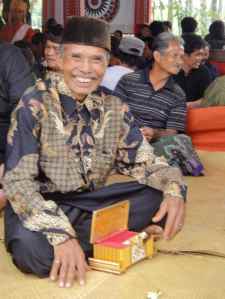

It’s a celebration. A good show. Months of planning and crippling financial investment reach its culmination in days of processions and ritual.
Not only what the dead man would have wanted. But what he worked his entire life to achieve.
It would be fair to say, however, that the nine year old does not entirely appreciate this masterclass in comparative religion and ethnology. He is concerned by the condition of the pigs.

Some of them are foaming at the mouth. Others urinate and defecate uncontrollably. Immobilised by their bamboo carrying poles, dumped on the ground like so many sacks, they alternate between panicked screaming and a desperate panting.

This prize sow will, apparently, be spared the coming holocaust. Which is why someone has covered her in rattan leaves, a token attempt at shade.
“This is making me nauseous,” Z says. “Can we go yet?”
“No,” I say, pompously. “This is a once in a lifetime opportunity to see an authentic animist funeral. We can go after the sacrifices.”
“Mum…” he says.
“Have you ever seen a buffalo sacrificed?” I ask.
“No,” he says.
“Me neither,” I say. “So we should. But you don’t have to look if you don’t want to.”
Z has done really well, in fact. He’s eaten lunch (plain boiled rice — after a look at his expression when confronted with the pork, I explained in my pidgin Indonesian that “Child Eat Boiled Rice. No More. Thank You. I Eat. Very Good. Good good!” ). And he has done so using his right hand, not his left.
Two strapping chaps begin to dig a hole in the ground, in front of the decorative rice barns under whose porticos the elite guests sit.
“I really don’t like this,” Z says. “Do you see that buffalo there? He’s got blood coming out where the ring goes through his nose.”
Torajans reckon their wealth in buffalo. Even an entry-level bovine costs thousands of dollars: a blue-eyed, albino version will sell for around 250 million rupiah (or well over 25 thousand US dollars). More than the price of the most elaborate tongkonan and many times the price of the car.
Throughout their lives, they work to amass these precious creatures, and tend them with a deep affection. Not necessarily as rice farmers, any more, though this is how the dead man acquired the wealth demonstrated for the first time at his funeral and the rich soil of the highlands supports three rice harvests every year. Today, they could be computer repairmen, teachers, motor mechanics, tour guides…
Then, as family members die, the buffalo are sacrificed, in an epic of conspicuous consumption and family togetherness that puts the average Western wedding quite to shame.
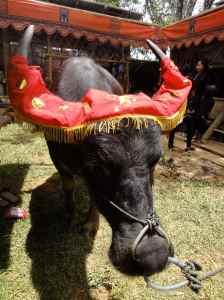
Bill, the dead man’s Australian son-in-law, up from Jakarta for the occasion and resplendent in black shirt and black funeral sarong, has invited us for coffee and tea.
“I’m sorry for your loss,” I say, rather awkwardly, given that we are here, essentially, to gawp.
“It’s alright,” he says. “He’s been dead since December, so it’s pretty much in the past.”
“December?!” I say.
“Yeah,” he says. “They’ve been getting together the money for the buffalo. It takes months to do that. Sometimes years. They’re expensive things, buffalo. And people round here don’t earn much. I bought three of them,” he adds, wryly. “I mean, my wife did…”
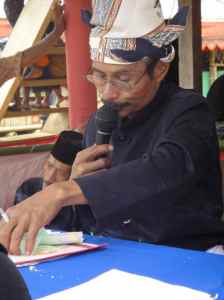
The MC continues his perorations, reciting the gifts brought and the names of their donors, inscribing each on old-fashioned carbon duplicate forms.
The local Protestant pastor will show up later in the day, after the sacrifices are safely complete and before too many of the jerry cans of palm wine and rice spirit have been drunk, to give a form of eulogy. I imagine a character straight out of Anthony Burgess’ Malayan Trilogy, returning home to gin and obliteration at the hopelessness of his flock.
A handler brings forward one of the ten or so buffalo which scatter the grounds, stroking his forehead and murmuring soothingly. The diggers produce the widest bamboo pole I have ever seen – almost a foot in diameter, I would guess.
At the sight of engineering, Z’s colour lifts noticeably.
“Oh,” he says. “Do you think they’re digging the hole to put the stake in?”
“I reckon so,” I say.
“I think that’s the buffalo they’re going to sacrifice, don’t you?”
The chaps secure the bamboo pole with three wooden stakes, each three or four inches in diameter. A screaming pig is unceremoniously dumped on the ground behind the pole, where it squawks and grunts itself into submission.
Another procession of women files past. The women of this branch of the family are wearing lilac tops. Rather, I think, like bridesmaid’s outfits in the west.
The concept of family in the Toraja is an extensive one: a better translation might be “kin” or “clan”. It encompasses everyone up to grandparents (their siblings, their children, and their children’s children), and everyone below that.
The dead man was ninety-four with nine surviving children of his own from a sequence of wives. The relatives have invested in a ton and a half of rice to feed guests over the week, and round the back of the guest constructions guys are killing, singing and butchering pigs around the clock.

Poorer neighbours have set up temporary stalls under the bamboo guesthouses and on the track leading up from the main road.
Martin, our guide, remarks with ill-concealed envy on the number of buffalo. “He was a very rich man,” he says. “And his children have very good jobs. They’ll probably kill only one today. Another one or two tomorrow. Then seven or eight on the sacrifice day.”
Martin’s father died relatively recently. So he owns no buffalo any more. Although a poor family, they put together a ten-buffalo funeral. But nothing on the scale of this.
It rankles.
The buzz of expectation grows. Now, Z and I both eat meat. Whole-heartedly. Bloody fillet. Bleeding roast beef. Tartares, kidneys, liver…
But, as urban creatures, neither of us has ever seen an animal being killed. The closest we’ve come to the living, bleeding source is the whole sucking pig I bought Christmas one year, which a five year old Z, with absolutely no sentimentality whatsoever, insisted on carrying proudly from the butchers.

Some of the young mourners hold ceremonial axes, like the ones which decorate the balcony of the house. But the guy who performs the sacrifice is not in costume and holds only a butcher’s knife. There is no incantation. I wonder, idly, how this ritual would have looked before the missionaries arrived.
The pig dies first, so quietly and matter of factly I almost miss it. The slaughterer bends down, opens the back of the pig’s neck from ear to ear, and catches the blood in a length of bamboo. The creature does not even have the time to scream before its soul is racing into the afterlife.
Though out in the boiling sun, its fellow swine scream in sympathy.
The buffalo is secured to the stake with a halter that runs to its ankle. His handler strokes his nose and murmurs to him lovingly, soothingly. I think of the hecatombs of Homer’s Iliad, the mass slaughter of hundreds of oxen, the moment when the axe fell…
“You need to move back,” says Martin. “It’s dangerous.”
Dangerous? I think. The buffalo is tranquil, calm, doe-eyed, as slow in its movements as any cud-chewing Anchor cow. In all our time in Asia, I have not once seen a buffalo move at anything other than a snail’s pace.
We move back. And then it happens very quickly.

The handler takes the knife. Whips it across the animal’s neck so fast I cannot see it, and leaps out of the way, cobra-speed. The gash gapes open, filling the air with a fine spray of vermilion arterial blood.

The buffalo rears on its hind legs, gallops the length of its halter at phenomenal speed then stumbles, felled by the rope, onto its side.
There it jerks and spasms, trying hopelessly to rise, the gash widening each time it raises its head, a gush of fresh, well oxygenated blood the colour and consistency of Strawberry Ribena sullying the grass, eyes more doelike by the second, mouth open in a soundless bellow, over a tonne of death writ very, very large.
As Z says, “It’s an ugly sight.”
But it’s mesmerizing, too. One’s gaze is drawn away, then back, away, then back.
Maybe I need to read more Hemingway. But I never knew how long a buffalo takes to die. This one alternates between minutes of quietude, chest juddering, eyes blank, blood leaking from its neck, and moments of active struggle, when it lurches upwards as if galvanised by electricity, Frankenstein-style, while guests carry yet more screaming pigs up the hill.
As the dogs begin to sniff around it, and the pool of blood congeals, the buffalo’s soul passes, finally, into the ether, to carry the dead man’s soul on its journey to the afterlife. Z tugs at my arm. We make our farewells. The funeral will continue for several more days. But he has seen enough*.
Thanks to Debbie at Delicious Baby for hosting Photo Friday.
*: You can read his take on proceedings here. On balance, he is glad he went.




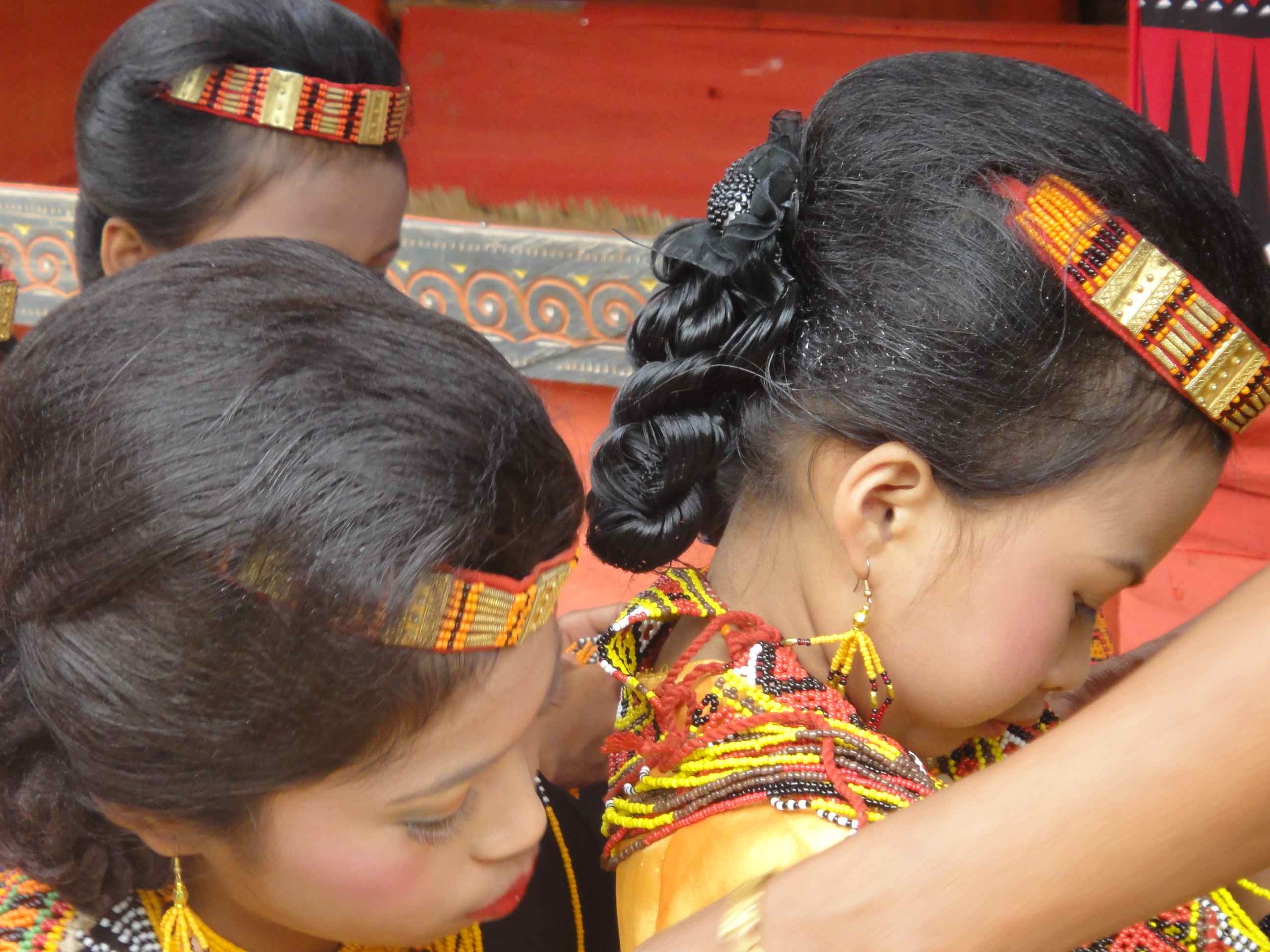
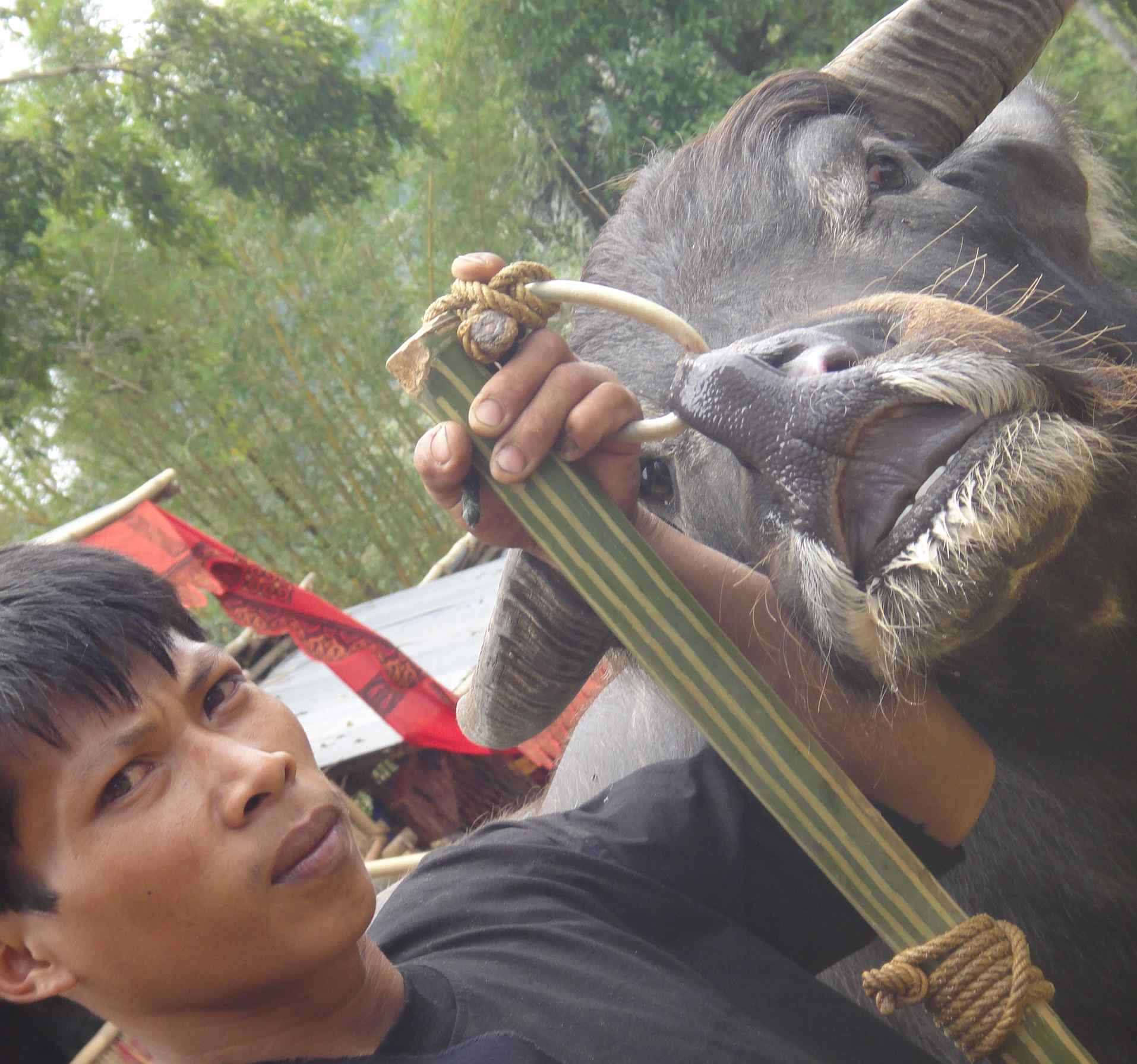



I don’t know if I could have watched. I don’t even like to go fishing because I can’t stand that moment when something alive becomes something dead.
Anyway, it was fascinating to read about the funeral traditions, with the costs (yikes!) and the costumes. And keeping the body in the house for 8 months . . . is the body wrapped in something special to reduce the smell?
Oops! Just reread the first part and saw that the body is preserved in formalyn. And at least the body is in a coffin, as opposed to being laid out in the open for such a long time.
Some families spend two years saving for the buffalo for the funeral, so the body lasts an entire two years. Apparently sometimes the family does the preservation themselves, other times they get in the professionals…
I’ve always thought that there is nothing more fascinating and illuminating than the way that different cultures approach death (and birth). This post was utterly fascinating.
Oh, and btw. I think you really should hot foot it home son. You really are learning nothing of any value or intellectual credibility out there. ;<)
M2M
Absolutely with you on death and birth. It’s an extraordinary culture.
I really wish I’d had the chance to chat to the priest. Not so much about the sacrifice but the notion that the soul does not cross over until the second funeral, so the man was not really dead.
Mmmm. Wish I hadn’t checked my emails just before I go to bed – it’s the photos. I’m already close to being vegetarian & now it seems like a no brainer.
Has it put you off eating meat at all?
Mish x
Weirdly, no. Z neither. We both ate buffalo last night, in fact.
It was slightly odd eating the pork at the funeral. It was delicious. But felt very wrong. The fat really, really grossed me out, having seen it exposed in the butchered creature, and I actually left it. Which was bad manners, but I figured gagging or puking would have been worse.
Normally I would have insisted that Z eat a bit of everything to be polite, but this time I was very supportive of his desire for plain boiled rice. I was a vegetarian in my teens. Not sure I could go back there now…
What an amazing education your given Z. Not always the most pleasant but real.
Thank you… It was very, very real. We’re off to the Togian islands next, which should be generally gentler. Northern Sulawesi gets very, very real indeed, apparently. Everyone we’ve met down south says ominously, “They eat strange things up north”…
Amazing experience… no doubt Z will be entertaining friends in the decades to come of the adventure that his mum took him on…
That or his therapist… I do hope the former 😉
Wow, what an amazing experience while I would love to see this I am not sure my 9 year old would do so well. Thanks for sharing this
You might be surprised…
Really great story.
We lived on an island when my kids were five and two and they regularly witnessed goat and pig butcherings on the beach, entrails floating out to sea. It’s where my five year old learned what meat is, and decided she would never eat another animal. She’s almost 12 now, still does not eat animals. My son, on the other hand, is quite carnivorous.
Yes, I’ll hope to avoid the therapist in the future as well, but am so grateful for their real world experiences. Keep posting your stories!
Thank you, sweet lady.
What an amazing experience (and photos!)
I have to admit that as a vegan I find the thought of slaughtering animals off-putting but I am realistic enough to realise that cultural sensitivities are probably the most important thing when you are participating in the death rituals of a family. Thanks for capturing it all in such detail and sharing it with us. Your son is really getting to see the world.
I can imagine you would find it off-putting. I’m honestly not sure if it makes it better or worse from a vegan perspective that the corpses are consumed in their entirety. But, to be honest, I find cruel cultural practices much easier to accept than (eg) cruel tourist attractions, or exploitation projects marketing themselves as conservation.
just reading this (and the comments again). “Off-putting,” hmmm…. hadn’t heard that term. But, I can completely understand vegans/vegetarians wherein they don’t eat animals and I can see how killing an animal or seeing it killed could completely change your outlook on the eating of the flesh of another creature.
So, as I’m reading this, it reminded me of a an incident in 2002. I had shot a deer in Texas and was driving it home (it was tied to the roof of my truck) and a woman – a rather large (obese) woman – in a rather obese Sport Utility Vehicle – rolled her window down and began to chastize me for making her “suffer” through looking at the poor dead “Bambi” for 30 seconds until the light turned green.
I can’t remember what I replied to her as she sat in her LEATHER seats, her skin coated with lotions and makeup made from animal products. I wondered how many cheeseburgers she had to consume to put on that extra 70 kilos of weight? But I did think of how I “appreciate” meat a lot more after having hunted and butchered it myself. I do eat a lot healthier since, waste less and appreciate that it WAS a living creature.
I wonder if more overweight westerners had a had in the killing – or at least witnessed it, we might have more vegans and/or people who respect where their food comes from…? just my .02 cents…
Now, that comment really speaks to me. Because, see, before seeing an animal killed for the first time (I’m 36 – Jeez!), I would have read an observation on hunting and butchering connecting you to the animal as just so much rightwing bullshit (particularly when you throw in Texas). Now, I absolutely understand where you’re coming from, and I do believe it’s true.
Rather as I mocked poor little Z initially when he said a grace apologising to the fish he’d killed (his first fishing mission) and thanking it for the gift of its life. He was right. And I think you’re right too.
I agree that if we were closer to the means of production of everything, not only meat, we in the West would waste a lot less. And, yes, we’d have more vegans, too. Because veganism, while not something I could personally do, is an ethical stance I whole-heartedly respect. As is, for that matter, vegetarianism.
Soooo with you on leather, too. I was veggie for third world reasoning: 100lb of corn to produce 1lb of beef (or whatever the maths was, I forget): so I wore leather. But you can’t get squeamish over dead animals while sitting on leather seats.
Well, as you say, at least the animal was utilised for meat afterwards. And Scotttraveler, that is such an excellent point – why are ‘cute’ animals (and horses) exempt? Do people not think about leather, and burgers, and pretty much most cosmetic products? (rhetorical question).
I have helped slaughter animals in my past, and plucked so many fowl I don’t even want to try and count. So I know about being close to food sources. And I frankly have more respect for people in a situation like the one you described here (even though I don’t condone it) than what goes on when it comes to using animal products in the ‘West’.
Sorry to de-rail, I just find it an interesting point. I promise my next comment will be something warm and fuzzy 🙂
I don’t think you’ve derailed at all! It’s a thoughtful response, and an interesting point. Particularly about cuteness: cf the moral outrage about eating dogs. (Or donkeys, for that matter. Or horses…)
Good to have a vegan perspective on it, to be honest. When did you turn vegan?
Thanks for sharing this, great photos and a very interesting set of observations. I took my 10 and 12 year olds to Thailand many years a go and I know their observations of rural life there, where people are so relatively poor was very worthwhile. As an aside, one of the replies mentioned cute animals being exempt from the food chain, so thought I would share this moment. I’m Aussie but live in Vietnam with my Vietnamese wife. On a trip home I bought some Kangaroo meat to take back, knowing that she had never tried it (it’s very nice by the way with very little fat.) She watched me cook it with some interest, “its really Kangaroo” she asked many times. Once it was served I sat down with her to eat to see her staring at her plate and seriously contemplating her first bite. For probably the first time ever I finished my meal first as she slowly ate. I asked her how it tasted and she told me it was nice, but….. I knew when I looked at her face what the problem was and she confirmed it for me, “but I dont know how you can eat, Kangaroo are so cute, please don’t buy any more”
forestblogging: how right you are – why are cute animals “exempt?” I tried so hard to keep this as my primary thought as I saw dogs butchered in China and Goats in Mongolia. Who am I to judge that a Chinese person eats a dog when I eat pig (offensive to Muslims) and beef (offensive to Hindus). So, I try to be a good traveler and watch and learn.
Not to sidetrack here, but one blogger that I’ve followed for years wrote a beautiful piece about her interactions with an Indian woman whilst flying from here to there. Her observations opened my mind to some cultural insensitivities that had never occured to me before. Mum T, hope you don’t mind if I link to it, I think that you’ll find it a really good read:
http://solbeam.com/2009/09/marbled-black-lab-and-yes-im-in-india-again/
as for the goats and dogs on the menu, they’re both linked here:
http://scotttraveler.wordpress.com/2009/12/03/fish-or-vegetables/
anyhows, cheers again on your blog, you have a natural talent for writing and I do enjoy reading about your adventures…
Great links: thank you for sharing…
Goats, I am fine with: because I like to eat goat curry (Jamaican or Indian, both delicious). Though waking up to one being slaughtered in Mauritania was one of my all-time travel lowpoints. Something about the heat, the flies, and the fact that it was only, like 5am, and I’d been sleeping on the sand under a sarong, and goat in Mauritania was also my all-time travel food low.
Dog, I haven’t eaten, though I intend to, for curiosity’s sake. Z didn’t fancy trekking 10k out of town in hanoi to dog alley. but in northern Sulawesi they eat all KINDS of crazy stuff, so I guess I’ll make an afternoon of it. Seeing a dog butchered, I think, would be hard for me. I don’t actually like them particularly, but they are still “friend, not food”.
You might enjoy this piece from a woman whose writing I love a lot, too, on dogs, in Vietnam: http://eastsidecurry.wordpress.com/2010/03/03/mans-best-friend-or-mans-best-dish/
One of the things I find weirdest about food is, actually, not the culturally relative bits, but simple palate. In Indonesia, avocado comes as a drink, with sweet milk. It’s a fruit… You should have seen the woman’s face in the warung we went to when I saw her avocados and requested that she cut them, and bring oil, salt and vinegar.
I have been thinking a lot lately about how hypocritical it is for me to eat meat but not be able to do the killing myself (or watch the killing). I do think that witnessing an animal’s death, when that animal is intended to be my food, definitely makes me question my eating habits and whether it is necessary for an animal’s life to be sacrificed so that I can “enjoy” a meal. (Kudos to Z for giving thanks to his fish!) I think that I might feel differently if food items were scarce, and I were dependent on killing an animal for my survival. For example, both of my parents were extremely poor and were raised in environments where they had to kill chickens and other animals to help feed their large families.
Also, it is peculiar indeed how different cultures look at certain animals as “food” or “friend.” On our recent travels to Yangshuo, China, our family (with 2 kids, then ages 7 and 10) took a cooking class in which we started at the local indoor market. As soon as we walked in, I could hear the dogs screaming in the back, as they were being butchered (and then skinned and chopped into pieces). Two European travelers staying at our hostel had taken the class the day before, and had mentioned that they had had some difficulty in watching the dogs shaking with fear in their cages, the killing, and the skinning; both men suggested that we consider skipping that portion of the tour.
We have had dogs as pets in the past–some incredibly smart and sensitive beings who were “part of the family”. We had mourned their deaths. Perhaps because I am intimately familiar with the intelligence and emotional depth of dogs, I didn’t even want to see them in cages, waiting to be killed. Anyway, we chose to go outside when the group veered toward the dog area.
Kathy, that was my “exact” experience that I linked above: Yangshuo, cooking school, walk to the market, dogs in the back. Oh, cats too. And yes, they eat cats in China…
I can’t say that I’d consciously go for dog, knowing what it is, curiosity or not. Luckily, I had it “by accident” wherein I ordered a meat sandwich and 1/2 way through it I was told it was dog (in rural Russia of all places, they feed “whatever” they can find to the tourists). It didn’t surprise me as it had a peculiar taste that I’d never tasted before. Can’t say that it “tastes like chicken,” it tasted like 4 day old beef that was left out of the fridge. Anyhows, when I had learned it was dog, I felt bad, but I decided to finish it. Like Z giving thanks to the fish, I would have felt bad to throw it out after the dog gave his life, so I said, “thanks dog,” and finished it.
Cathy, I probably put the “opt for dog” a little fliply. I do intend to visit this very extreme market near to where we are now, and also try various things there. I’m curious about taboo foods in general (not just the cruel ones but the odd ones: durian, stinky tofu, insects) but I’d be very interested to see what the emotional response is there. I think most people who try eating dog find it emotionally quite difficult — though the fact that I can easily contemplate it means I’m one of the least emotional about it — and I’m curious as to whether I’ll feel the same.
Mish posed a good question on Z’s blog, actually. Whether either of us had felt like turning vegetarian. Which, in fact, neither of us had…
What an amazing experience, I loved your description of the whole thing – these are the things that define each culture, life and death. In papua new guinea I saw a bull slaughtered by clubbing around the head – not a very pretty sight. I wrote a post myself about different ways of remembering the dead in different culture.
http://www.heatheronhertravels.com/blue-hearts-and-ghost-bikes-ways-to-remember-the-dead/
Thanks for the link, Heather! We saw an amazing funeral in Bali — cremation of the last king of Peliatan — which gave yet another perspective on death, and the absolute unimportance of the body. Here, too, they’ll keep the body for months, if not years, while they arrange the obsequies.
I don’t think I’d enjoy seeing this. But it’s nice to read about.